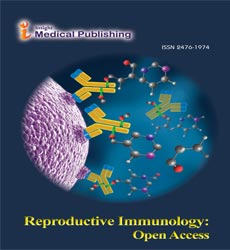Cellular and Molecular Mechanisms in Reproductive Immunology
Nihar R Nayak
DOI10.21767/2476-1974.100022
Department of Obstetrics and Gynecology, Wayne State University School of Medicine, Detroit, Michigan, USA
- *Corresponding Author:
- Nihar R Nayak
Department of Obstetrics and Gynecology
Wayne State University School of Medicine
Detroit, Michigan, USA
E-mail: nnayak@med.wayne.edu
Received date: September 01, 2016; Accepted date: September 02, 2016; Published date: September 06, 2016
Citation: Nayak NR (2016) Shift in Macrophage Polarity and Preeclampsia. Reproductive Immunol Open Acc 1:22. doi: 10.4172/2476-1974.100022
Copyright: © 2016 Nayak NR. This is an open-access article distributed under the terms of the Creative Commons Attribution License, which permits unrestricted use, distribution, and reproduction in any medium, provided the original author and source are credited.
Editor Note
Reproductive immunology is a field of medicine which studies the interactions between reproductive tissues and the immune system. It offers solutions to various reproductive disorders associated with immune dysfunctions, such as infertility problems of men and women, recurrent miscarriages, cancers of reproductive tissues, fibroids, and various pregnancy complications. Reproductive Immunology: Open Access (RIOA) is an international, peer-reviewed, journal that publishes new articles in all the related topics of reproductive immunology. The main goal of the journal is to provide a forum for researchers and clinicians to disseminate new research findings and concepts related to the field of reproductive immunobiology. Here, we highlight several novel findings recently published in RIOA.
Using a genome-wide association study (GWAS), Sugimoto et al. [1] provide novel insights into the role of friend leukaemia integration 1 (FLI-1), a member of the ETS gene family of transcription factors, in regulation of conception rates in Holstein cows. They have shown that cows with higher conception rates have the GA polymorphism in the FLI-1 5’ untranslated region and express higher levels of FLI-1 transcripts with the GA polymorphism. Furthermore, they have shown that cows with the deletion polymorphism had lower conception rate after embryo transfer and had higher serum levels of perforin, a product of natural killer cells, which might have contributed to the lower conception rate in these animals.
McCracken and colleagues [2] have discovered a potential mechanism of suppression of the maternal Th1 immunity during normal pregnancy. They have shown that pregnancy derived Fas ligand (FasL) exosomes in maternal plasma regulate p65 levels in circulating T-cells through Fas activation, and that the suppression of p65 subunit of the nuclear factor kappa-light-chain-enhancer of activated B cells (NF-kB) in Tcells underlies the suppression of maternal Th1 immunity during pregnancy.
In a case report, Carbone et al. [3] have demonstrated an innovative approach to immunomodulation in women with recurrent pregnancy loss and immunological abnormalities. Although the safety and efficacy of this approach needs further evaluation in large clinical trials, the authors have successfully demonstrated the tolerability and clinical efficacy of subcutaneous immunoglobulin therapy for unexplained abortion and multiple sclerosis.
References
- Sugimoto M, Baba T, Gotoh Y, Kawahara T, Sugimoto Y (2016) Friend Leukaemia Integration 1 is Associated with Conception Rate in Holsteins. Reproductive Immunology: Open Access.
- McCracken AS, Hadfield AK, Yenson MV, Ariyakumar G, McKelvey JK, et al. (2016) NF-kB Regulation in T-cells in Pregnancy is mediated via Fas/FasL Interactions: The Signal for which is Derived from Exosomes Present in Maternal Plasma.Reproductive Immunology: Open Access.
- Carbone J, Sarmiento E, Fernandez-Cruz E (2016) Subcutaneous Immunoglobulin Therapy in a Woman with Spontaneous Pregnancy Loss and Multiple Sclerosis.Reproductive Immunology: Open Access.
Open Access Journals
- Aquaculture & Veterinary Science
- Chemistry & Chemical Sciences
- Clinical Sciences
- Engineering
- General Science
- Genetics & Molecular Biology
- Health Care & Nursing
- Immunology & Microbiology
- Materials Science
- Mathematics & Physics
- Medical Sciences
- Neurology & Psychiatry
- Oncology & Cancer Science
- Pharmaceutical Sciences
